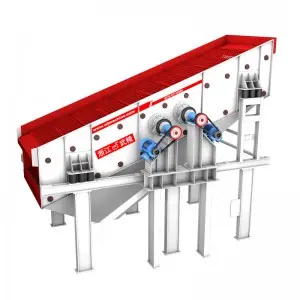Linear vibrating screen is a kind of screening equipment widely used in mining, building materials, chemical, metallurgy and other industries. Its main function is to classify and screen materials. The working efficiency of the linear vibrating screen directly affects the efficiency of the entire production line. Therefore, understanding the factors that influence the working efficiency of the linear vibrating screen is of great significance for improving production efficiency. This article will analyze the factors influencing the working efficiency of linear vibrating screens from the following aspects.
First, the working principle of the linear vibrating screen
When the linear vibrating screen is in operation, the excitation force generated by the vibrator is transmitted to the screen box through the elastic element, and then the excitation force of the screen box is transmitted to the screen mesh, causing the screen mesh to vibrate continuously and periodically, thereby achieving the purpose of screening and filtration. The materials are evenly fed into the feeding port of the screening machine through the feeder, and are screened on the screen surface. The materials that meet the specifications pass through the screen mesh into the hopper and are discharged through the discharge port. Materials that do not meet the specifications are continuously blocked on the screen surface and discharged through the outlet of the screening machine. During the material screening process, the materials and fine powder flow together. Most of the materials with a higher specific gravity pass through the screen holes and directly fall to the bottom of the vibrating screen, becoming the under-screen material. The materials with a smaller specific gravity rush towards the overflow weir with the wave crest and then overflow through the weir opening to the discharge port to become the materials on the screen. During this process, when materials with a higher specific gravity pass through the screen holes, they will encounter greater resistance than normal. This is because during the vibration of the vibrating screen, in addition to the up and down reciprocating motion, there is also the centrifugal force effect of left and right rotation. This force will prompt the material to move from the screen holes to the edge position, thus allowing fine-grained materials to pass through near the screen holes and become under-screen materials. Coarse-grained materials move towards positions far from the screen holes. After multiple jumps and movements, they gradually gather at the discharge port and are discharged as the material on the screen.
Second, factors affecting the working efficiency of linear vibrating screens
1.Selection and installation of vibrating motors
The vibrating motor is the core component of the linear vibrating screen, and its performance directly affects the screening effect and working efficiency. Therefore, choosing the appropriate vibrating motor and installing it correctly are the keys to improving the working efficiency of the linear vibrating screen. Firstly, the excitation force of the vibrating motor should be matched with the load-bearing capacity of the screen machine to ensure that the screen machine will not be damaged due to excessive excitation force during operation. Secondly, the installation position of the vibrating motor should be reasonable. Generally, it should be installed near the center of gravity of the screen machine to ensure that the screen machine can maintain a stable vibration state during operation. In addition, the maintenance and care of vibrating motors are also important factors affecting their working efficiency. Regular inspection and maintenance of vibrating motors can effectively extend their service life and improve the screening efficiency.
2. Selection and tensioning of screen mesh
The screen mesh is the main working component of the linear vibrating screen. Its material, pore size and tension directly affect the screening effect and working efficiency. Therefore, choosing the appropriate screen mesh and conducting the correct tensioning are the keys to improving the working efficiency of the linear vibrating screen. First of all, the material of the screen should match the nature of the material to ensure that the screen will not be damaged during operation due to the nature of the material. Secondly, the aperture of the screen should match the particle size of the material to ensure that the material can pass through the screen smoothly for classification. In addition, the tension of the screen should be moderate. If it is too tight or too loose, it will affect the screening effect and work efficiency. Generally speaking, the tension degree of the screen mesh can be achieved by adjusting the screen mesh fixing device to ensure that the screen mesh can maintain a stable tension state during operation.
3. The magnitude and mode of the excitation force
Excitation force is one of the main factors affecting the working efficiency of linear vibrating screens. Generally speaking, the greater the excitation force, the greater the vibration amplitude, the faster the movement speed of the material on the screen surface, and the higher the screening efficiency. However, if the excitation force is too large, it will cause the material to break or clog the screen holes, thereby affecting the screening effect. In addition, different excitation methods will also affect the working efficiency of the linear vibrating screen. The commonly used excitation methods include double-axis and single-axis. The biaxial excitation mode refers to the excitation force generated simultaneously by the exciter in two mutually perpendicular directions, causing the screen box to move in a plane. The uniaxial excitation mode refers to the excitation force generated by the exciter only in a single axial direction, causing the screen box to move in one direction. The biaxial excitation method can enable the material to obtain greater acceleration and velocity on the screen surface, thereby improving the screening efficiency and production capacity.
Post time: Jun-12-2025

